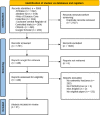There are more things in physical function and pain: a systematic review on physical, mental and social health within the orthopedic fracture population using PROMIS
- PMID: 35384568
- PMCID: PMC8986932
- DOI: 10.1186/s41687-022-00440-3
There are more things in physical function and pain: a systematic review on physical, mental and social health within the orthopedic fracture population using PROMIS
Abstract
Background: The Patient-Reported Outcomes Information System (PROMIS®) is more and more extensively being used in medical literature in patients with an orthopedic fracture. Yet, many articles studied heterogeneous groups with chronic orthopedic disorders in which fracture patients were included as well. At this moment, there is no systematic overview of the exact use of PROMIS measures in the orthopedic fracture population. Therefore this review aimed to provide an overview of the PROMIS health domains physical health, mental health and social health in patients suffering an orthopedic fracture.
Methods: This systematic review was documented according to the Preferred Reporting Items for Systematic Review and Meta-Analyses (PRISMA) guidelines. We searched Embase, Medline, Web of Science Core Collection, and Cochrane Central Register of controlled Trials, CINAHL and Google Scholar in December 2020 using a combination of MeSH terms and specific index terms related to orthopedic fractures and PROMIS questionnaires. Inclusion criteria were available full text articles that were describing the use of any PROMIS questionnaires in both the adult and pediatric extremity fracture population.
Results: We included 51 relevant articles of which most were observational studies (n = 47, 92.2%). A single fracture population was included in 47 studies of which 9 involved ankle fractures (9/51; 17.6%), followed by humeral fractures (8/51; 15.7%), tibia fractures (6/51; 11.8%) and radial -or ulnar fractures (5/51; 9.8%). PROMIS Physical Function (n = 32, 32/51 = 62.7%) and PROMIS Pain Interference (n = 21, 21/51 = 41.2%) were most frequently used questionnaires. PROMIS measures concerning social (n = 5/51 = 9.8%) and mental health (10/51 = 19.6%) were much less often used as outcome measures in the fracture population. A gradually increasing use of PROMIS questionnaires in the orthopedic fracture population was seen since 2017.
Conclusion: Many different PROMIS measures on multiple domains are available and used in previous articles with orthopedic fracture patients. With physical function and pain interference as most popular PROMIS measures, it is important to emphasize that other health-domains such as mental and social health can also be essential to fracture patients.
Keywords: Fracture; Orthopedics; PROMIS®; Patient-reported outcomes; Trauma.
© 2022. The Author(s).
Conflict of interest statement
The authors declare that they have no competing interests.
Figures




References
-
- Pike C, Birnbaum HG, Schiller M, Sharma H, Burge R, Edgell ET. Direct and indirect costs of non-vertebral fracture patients with osteoporosis in the US. Pharmacoeconomics. 2010;28(5):395–409. - PubMed
-
- Nelson EC, Eftimovska E, Lind C, Hager A, Wasson JH, Lindblad S. Patient reported outcome measures in practice. Bmj. 2015;350:g7818. - PubMed
Publication types
LinkOut - more resources
Full Text Sources

